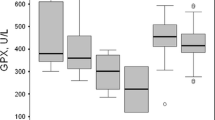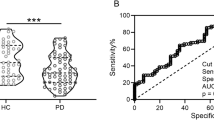Abstract
Objective:The inflammatory status is awell-documented factor influencing thedevelopment of oxidative stress in dialysispatients. This study intends to evaluate theinflammatory activity and the plasma levels oftotal antioxidant capacity (TAC) and lipidperoxidation products in patients on peritonealdialysis (PD), by comparison with hemodialysis(HD) patients.Patients and Methods: Plasmaconcentration of TAC, lipid peroxidationproducts and C-reactive protein (CRP) weremeasured in 24 patients on PD, 32 HD patients(pre and post treatment) and 16normal controls (NC).Results: All patients had higher levelsof TAC and lipid peroxidation products than NC(p < 0.001). Patients on PD, had similar levelsto patients before HD but significantly higher(p < 0.001) than those post HD. The CRPconcentration was higher in HD than in PDpatients (p < 0.05). The percentage of patientswith CRP > 10 mg/l was 48% in HD patients and21% in PD patients. No correlation was observedbetween CRP and TAC nor CRP and MDA levels.Conclusions: We conclude thatalthough PD and HD patients show an equalsusceptibility in oxidative stress, CRPlevels are higher in HD patients and this isindicative of a higher degree of inflammatoryactivity in these patients.
Similar content being viewed by others
References
Tetta C, Biasoli S, Schiavon R, Inguaggiato P, David S. An overview of hemodialysis and oxidative stress. Blood Purif 1999; 17: 118–126.
Fiorillo C, Oliviero C, Rizzuti G, Nediani C, Pacini A. Oxidative stress and antioxidant defenses in renal patients receiving regular hemodialysis. Clin Chem LabMed 1998; 36: 149–153.
Morena M, Cristol JP, Canaud B. Why hemodialysis patients are in prooxidant state? What could be done to correct the pro/antioxidant imbalance? Blood Purif 2000; 18: 191–199.
Mimic-Oka J, Simic T, Djukanovic L, Reljic Z, Davicevic Z. Alteration in plasma antioxidant capacity in various degrees of chronic renal failure. Clin Nephrol 1999; 51: 233–241.
Donica H. Evaluation of lipids peroxidation products vs. proinflammatory cytokines in hemodialyzed patients. Ren Fail 2001; 23: 231–238.
Jackson P, Loughrey C, Lightbody J, Mc Namee P, Young I. Effect of hemodialysis on total antioxidant capacity and serum antioxidants in patients with chronic renal failure. Clin Chem 1995; 41: 1135–1138.
Dasgupta A, Hussain S, Ahmad S. Increased lipid peroxidation in patients on maintenance hemodialysis. Nephron 1992; 60: 56–59.
Daschner M, Lenhartz H, Bötticher D, Schaffer F, Wollschläger M, Leichsenring M. Influence of dialysis on plasma lipid peroxidation products and antioxidant levels. Kidney International 1996; 50: 1268–1272.
Docci D, Bilancioni R, Busocardi A, Baldati L, Capponcini C. Elevated levels of C-reactive protein in hemodialysis patients. Nephron 1990; 56: 364–367.
Nguyen-Koha T, Massy ZA, De Bandt JP, Kebede M. Oxidative stress in hemodialysis: role of inflammation and duration of dialysis treatment. Nephrol Dial Tranplant 2001; 16: 335–340.
Mc Intryre C, Harper I, Mac Dougal IC, Ralne AEG, Williams A. Serum C-reactive protein as a marker for infection and inflammation in regular dialysis patients. Clin Nephrol 1997; 48: 371–374.
Spittle MA, Hoenich NA, Handelman GI, Hamel P, Levin NW. Oxidative stress and inflammation in hemodialysis patients. Am J Kidney 2001; 38: 1408–1413.
Panichi V, Migliori M, De Pietro S, Taccola D. C-reactive protein as a marker for chronic inflammation in hemodialysis patients. Blood Purif 2000; 18: 183–190.
Kim SB, Yang WS, Min WK, Lee SK, Park JS. Reduced oxidative stress in hypoalbuminemic CAPD patients. Perit Dial Int 2000; 20: 290–294.
Taylor JE, Scott N, Bridges A, Henderson IS, Stewart WK. Lipid peroxidation and antioxidants in continuous ambulatory dialysis patients. Perit Dial Int 1992; 12: 252–256.
Dasgupta A, Malhorta D, Levy H, Marcadis D, Blackwell W, Johnson D. Decreased total antioxidant capacity but normal lipid hydroperoxide concentrations in sera of critically ill patients. Life Sci 1997; 60: 335–340.
Haubitz M, Brunkhorst R, Wrenger E, Froese, Schulze E. Chronic induction of C-reactive protein by hemodialysis but not by peritoneal dialysis therapy. Perit Dial Int 1996; 16: 158–162.
Herzig K, Purdie DM, Chang W, Brown AM, Hawley CM. Is C-reactive protein a useful predictor of outcome in peritoneal dialysis patients? J Am Soc Nephrol 2001; 12: 814–821.
Morrow DA, Ridker DM. C-reactive protein, inflammation and coronary risk. Med Clin North Am 2000; 84: 149–161.
Clyne B, Olshaker JS. The C-reactive protein. J Emerg Med 1999; 17: 1019–1025.
Miller NJ, Rice-Evans C, Davies MJ, Gopinathan V, Milner. A novel method in measuring antioxidant capacity and its application to monitoring antioxidant status in premature neonates. Clin Sci 1993; 84: 407–412.
Descamps-Latscha B, Goldford B, Nguyen AT. Establishing the relationship between complement activation and stimulation of phagocyte oxitative metabolism in hemodialysed patients: a randomized prospective study. Nephron 1991; 59: 279–285.
Schnindler R, Lonnemann G, Shaldon S, Koch KM, Dinarello CA. Transcription not synthesis of IL-1 and TNF by complement. Kidney Int 1990; 37: 85–93.
Topey N, Mackenzy R, Jörres A, Coles GA, Davies M. Cytokine networks in continuous ambulatory peritonel dialysis patients: interactions of resident cells during inflammation in peritoneal cavity. Perit Dial Int 1993; 13(Suppl 2): 282–285.
Author information
Authors and Affiliations
Additional information
An erratum to this article is available at http://dx.doi.org/10.1007/s11255-007-9248-0.
Rights and permissions
About this article
Cite this article
Samouilidou, E.C., Grapsa, E.J., Kakavas, I. et al. Oxidative stress markers and C-reactive protein in end-stage renal failure patients on dialysis. Int Urol Nephrol 35, 393–397 (2003). https://doi.org/10.1023/B:UROL.0000022846.83505.3f
Issue Date:
DOI: https://doi.org/10.1023/B:UROL.0000022846.83505.3f




